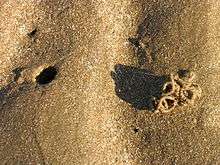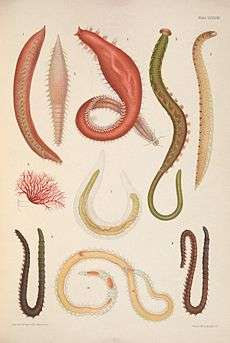Arenicolidae
Arenicolidae is a family of marine polychaete worms. They are commonly known as lugworms and the little coils of sand they produce are commonly seen on the beach. Arenicolids are found worldwide, mostly living in burrows in sandy substrates. Most are detritivores but some graze on algae.[2]
| Arenicolidae | |
|---|---|
 | |
| Cast and depression caused by buried Arenicola marina. | |
| Scientific classification | |
| Kingdom: | |
| Phylum: | |
| Class: | |
| Subclass: | |
| Order: | Capitellida |
| Family: | Arenicolidae Johnston, 1835 |
| Genera | |
|
| |
Description

The arenicolids are characterised by an elongated cylindrical body separated into two or three distinct regions. The prostomium has no appendages or palps. There are one or two anterior segments without setae. On the other segments, all the setae are unbranched, including the capillary setae and the rostrate uncini. The notopodia are bluntly truncate and the neuropodia are elongated tori forming long transverse welts in some of the setigers. The notosetae have either a capillary function or act as limbs and the neurosetae are rostrate hooks. There are branchiae present on some of the setigers in the middle or posterior regions.[3] Apart from the genus Branchiomaldane, the lugworms are not easy to confuse with other polychaetes. Their tough cuticle and their distinct branchial region with strongly tufted branchiae are characteristic.
Genera
- Abarenicola Wells, 1959
- Arenicola Lamarck, 1801
- Arenicolides Mesnil, 1898
- Branchiomaldane Langerhans, 1881
- Clymenides
- Eruca
- Protocapitella [1]
See also
- Arenicola marina
- Abarenicola pacifica
References
| Wikimedia Commons has media related to Arenicolidae. |
- World Register of Marine Species
- Fauchald, K. 1977. The polychaete worms, definitions and keys to the orders, families and genera. Natural History Museum of Los Angeles County: Los Angeles, CA (USA) Science Series 28:1-188
- The Polychaete Worms